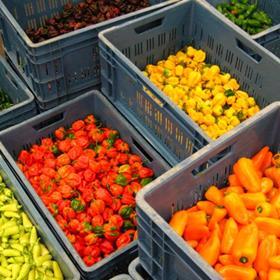
Tomato producer Looye’s decision to stop supplying Sainsbury’s last summer was evidence of a move away from the British market by some Dutch companies. The supplier’s founder Jos Looije believes the Netherlands will be less important for the British market after Brexit and he says it’s clear that the amount of Dutch produce being exported to the UK will decrease.
“None of us really knows what’s happening with Brexit,” he says, “but with Britain leaving the EU, the ‘local for local’ trend picking up and British companies investing in greenhouses, I think Holland will be less important in the British market in future. Everybody’s thinking that way.”
The company’s choice to stop working with Sainsbury’s was a “long-term strategic decision”, Looije says, explaining that short-term considerations like exchange rates were less important. The company will continue to supply Waitrose – a relationship that Looije described as “close” – but if the grower’s comments do indeed echo a wider sentiment in the Dutch fresh produce industry, we can perhaps expect other companies to scale down their UK supply too in the coming months.
On a domestic level, Looije says the biggest development in the Dutch tomato sector is the expansion of the major producers, with companies like Harvest House getting “bigger and bigger”. The produce giant now accounts for a third of Holland’s total tomato production.
Some 40 per cent of those tomatoes are now grown with the aid of artificial light, and more and more growers are installing artificial lamps, and to a lesser extent LEDs, in a bid to increase their yields. “It’s changed the game in Europe,” says Looije. “Quality is consistent now in the Netherlands, whereas in southern Europe the quality and amount of product can really vary depending on the weather. Tomato volumes from the Netherlands have increased a lot thanks to artificial lighting.”
Because of this growing preference for lit production, the tomatoes were less affected by a lack of light in December and January than other salad vegetables. Dutch peppers suffered more of a setback and are only just starting to come through. “Other than green peppers, the coloured caps are coming on to the market now,” says Joost van der Voort, commercial director at QPI.
These low light levels affected production more than the recent cold snap and although the ‘Beast from the East’ was less than ideal for growers, its minor impact was offset by a good amount of sunshine, with an average of around eight hours a day in February.
Tomatoes are also slowly starting to be harvested in small volumes, whereas cucumbers have been available since January. More generally, however, Looije says there isn’t really a clear ‘switchover’ in supply from Spain to the Netherlands any longer. “There’s so much artificial light in the Netherlands now and there’s quite a lot of winter production so the change from one season to another is less clear now than it used to be.”
In terms of production, the Netherlands’ acreage is increasing slightly in both tomatoes and peppers, according to Philip Brown, procurement commercial director at Keelings. The market for aubergines and cucumbers is fairly stable, but there is growing demand for snacking tomatoes, cucumbers and sweet bite peppers, Brown says. Meanwhile, planted area for medium vine tomatoes continues to decrease, with more large vine being grown since they give better returns to growers.
Another major development in Dutch salad veg is the ongoing push to improve sustainability. One important aspect of this is the increased use of geothermic heat, which uses the constant temperature of the earth as the exchange medium rather than the outside air temperature.Efforts to save energy have also included the growing use of screens to insulate glasshouses, as well as more careful control of their temperature and humidity. In addition, diffuse glass is often used when a new glasshouse is built, says Leo Marcelis of Wageningen University, and this ensures that light reaches deeper into the crop, illuminating a larger surface area of the leaf and allowing more photosynthesis to take place. Yield increases of five to ten per cent are the reward for growers, he says.
When it comes to growing techniques, Marcelis says that hydroponic production under LEDs is “an important new system”, with gradually more producers growing without soil and instead using a “nutrient film technique on small gutters or deep flow systems”. In cucumbers, meanwhile, the high-wire system continues to gain traction among growers, helping to increase yields, boost quality and save on labour.
As the high-tech Dutch salad sector continues to innovate in this way, it will be interesting to see whether the British market continues to benefit from its produce in the same volumes with Brexit looming large.



